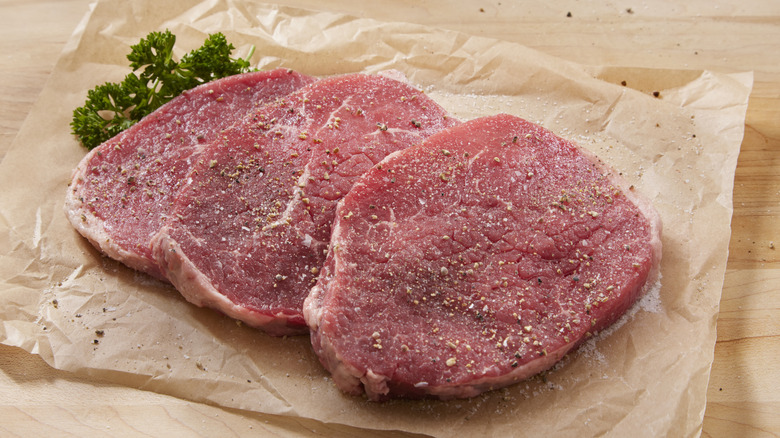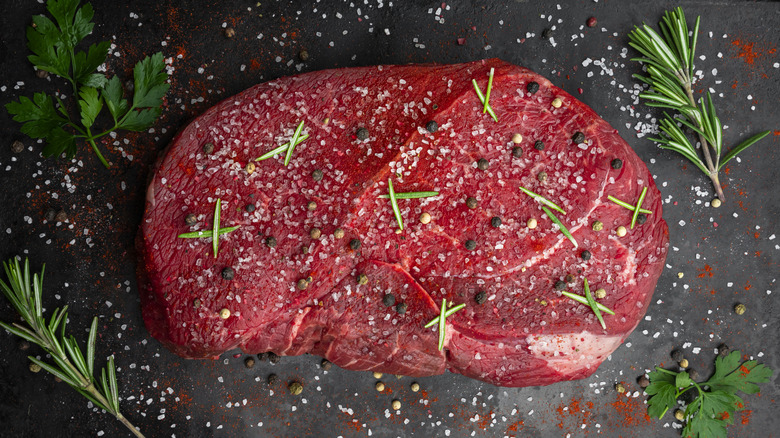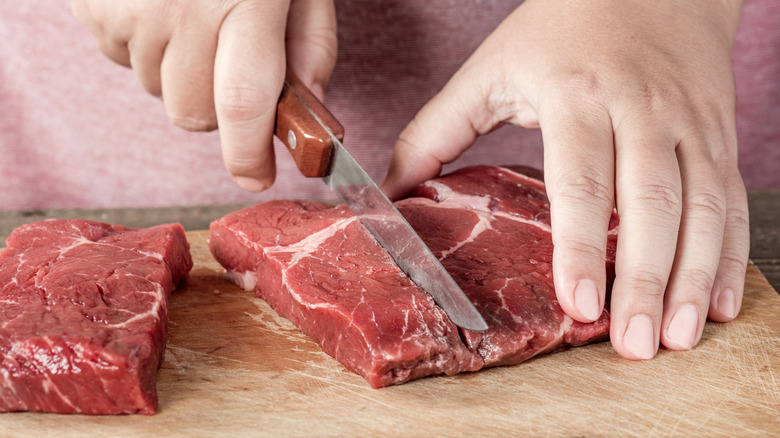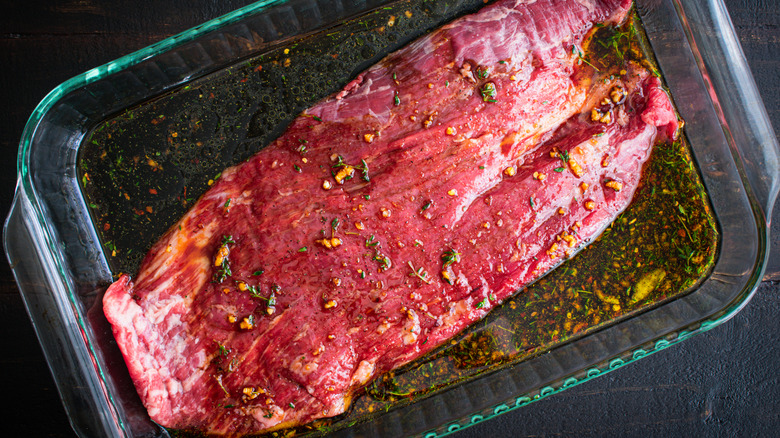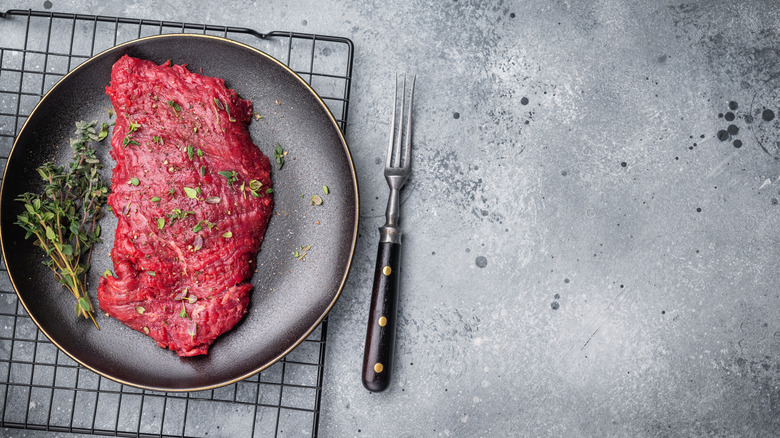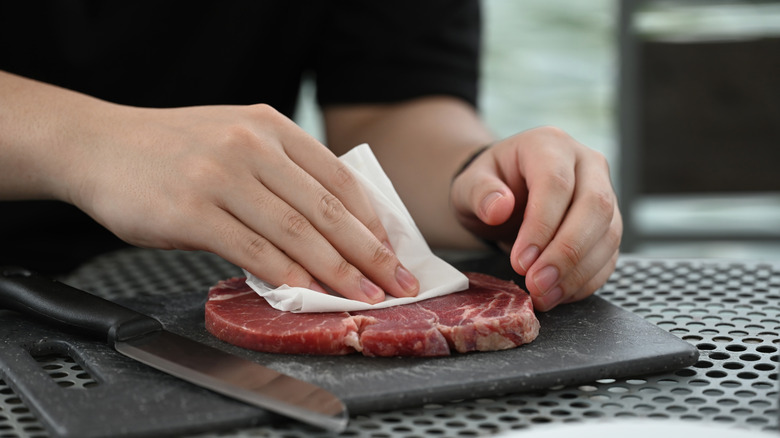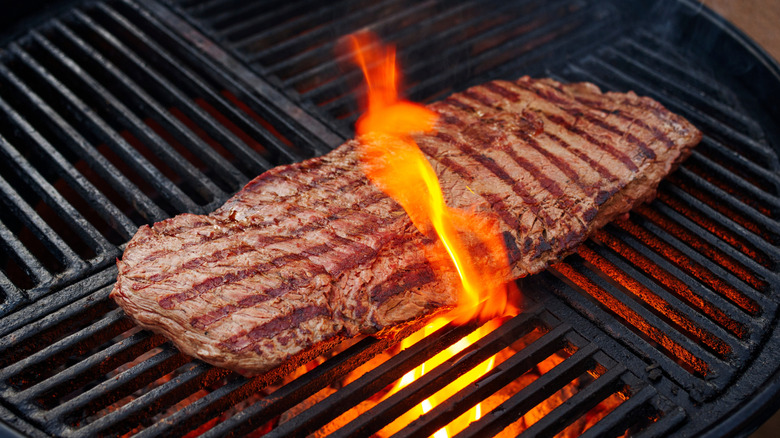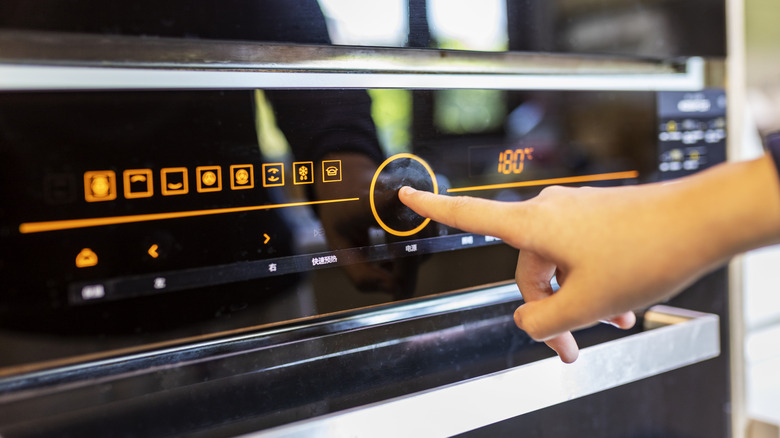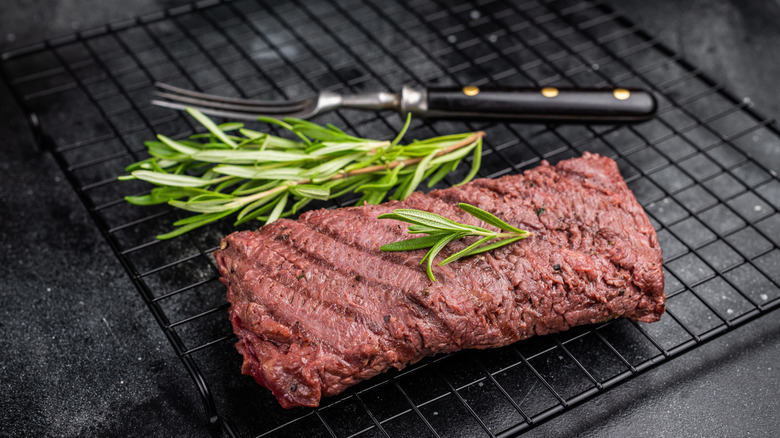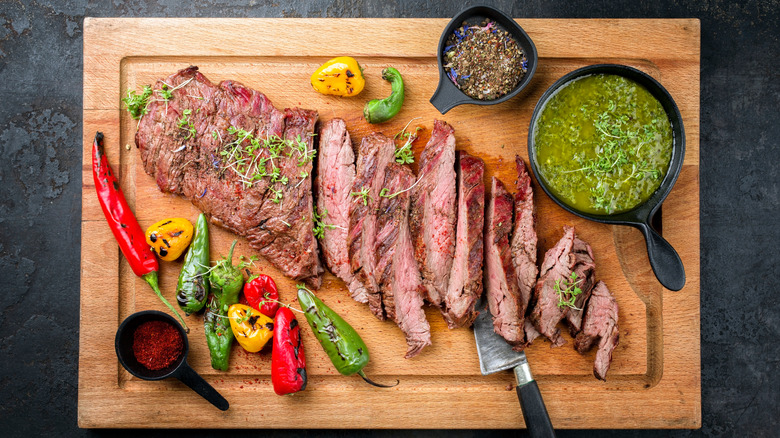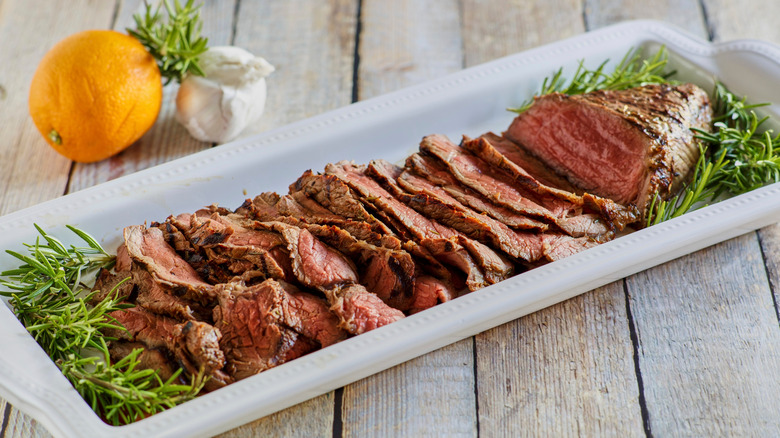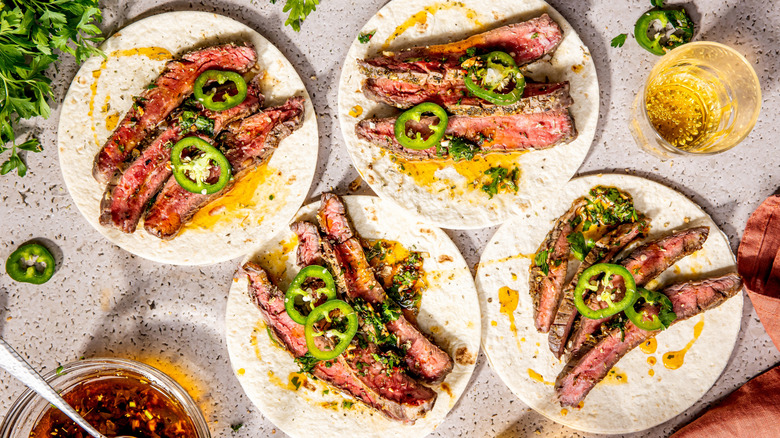14 Mistakes That Are Ruining Your London Broil
If you're craving a steak dinner but don't want to spend a fortune on meat, London broil is a good way to go. Contrary to popular belief, London broil is not a specific cut of meat, but rather a technique for getting the most out of a tough, lean piece of beef. And although the name may lead you to believe that it was developed in London, the dish actually originated in the U.S. At first glance, it might seem easy enough to make — just marinate the steak, then blast it under a broiler. However, there are some major missteps that could turn your steak into a dry, chewy disappointment.
To find out where many home cooks go wrong with London broil, we reached out to several chefs and meat experts to get their opinions. They clued us in to some of the biggest mistakes people make with the dish including questionable meat choices, marination errors, and cooking oversights. They offered us helpful advice on how to avoid those problems, as well as some tips for getting the best flavor and texture out of your steak. If you're aiming for a steak that's as tender and tasty as possible, you may want to steer clear of these common London broil mistakes.
Choosing the wrong cut of beef
The first mistake many people make is assuming they need to buy something labeled "London broil." While you might find that label displayed at some butcher counters, you can actually use the leanest cuts of steak for the dish. "We recommend top round, flank steak, or shoulder steaks," said Peter de Luca, owner of Vincent's Meat Market. "Our personal favorite is flank steak — it has a rich flavor and great texture when cooked properly."
Also known as jiffy steak or bavette, flank steak comes from the abdominal area of the cow and contains little to no fat. Top round comes from the rump and hind legs of the cow and is also a very lean cut of meat. Same goes for shoulder steaks. Because these cuts tend to be tough, they're often cheaper than more tender cuts like ribeye and filet mignon. In terms of what to look for in a good cut, Ryan Pitt, corporate chef at 40 Love Group, told us, "You want an even thickness, a little marbling, and no heavy gristle. If it looks like it could turn into a leather belt, keep moving."
Skipping a dry brine
One of the key steps in London broil is marinating the meat to tenderize it and infuse some flavor. However, Ryan Pitt told us there's one essential thing you need to do with your meat prior to that. He said, "Salt it early (dry brine) before you even think about marinating." A dry brine involves generously salting the meat and letting it rest (ideally for an hour or more) before the marinade goes on. This will give your meat far more flavor than just a marinade alone.
When you apply salt to the surface of the meat, it initially draws out moisture through osmosis. But given enough time, that salty liquid gets reabsorbed into the muscle fibers, seasoning the meat deeper than a marinade can. This process also helps loosen the proteins up, which improves tenderness. That's especially important for the lean, fibrous cuts used in London broil. Unlike a water-based brine (which may be ruining your meat), which mostly flavors just the surface of the meat, dry brining works from the inside out. The result is a steak that's both well-seasoned and more forgiving during cooking.
Neglecting to score the beef
Seasoning your meat is often forgotten, but Peter de Luca believes that the way you treat the surface of your meat is very important. He told us, "Before cooking, we like to score the surface of the meat at an angle, making a diamond pattern. This keeps the meat from buckling up and getting tough as it cooks, allowing for even heat distribution and a better texture." If you're not familiar with scoring, it involves making shallow cuts across the surface of the meat.
By scoring your steak, you create small incisions that allow heat to move more evenly through the meat. This is particularly useful for thicker or uneven cuts. Scoring also helps the marinade do its job better because it creates more surface area to cling to and small channels where the marinade can penetrate deeper into the meat. Just be careful not to cut too deep — about an eighth to a quarter inch is enough. You want to open up the surface slightly without compromising the structural integrity of the steak.
Not balancing the marinade
When we asked chef and butcher Brad Baych of Butcher Wizard if he had any pro tips for making a perfect London broil, he told us the marinade was key. "You would be amazed how much a great marinade can elevate this dish," he said. For him, that means using bold ingredients like balsamic vinegar or Worcestershire sauce, both which have acidic elements that can help tenderize the meat and umami flavor that can enhance the savoriness of the beef.
The key to a great marinade is using vibrant flavors that will complement the beef, but also keeping things in balance. You don't want to go overboard with strong flavors or make a marinade that's just one-note. Chef Maricel Gentile, author of Maricel's Simply Asian Cookbook, recommends building your marinade with a simple formula: "Use something acidic (like citrus or vinegar), something salty (like soy or Worcestershire), and aromatics." Peter de Luca agrees, cautioning against doing too much. He recommends a simple combo of olive oil, garlic, vinegar, and fresh herbs to add flavor without overpowering the beef.
Marinating for too long or too little
Finding the right window of time for marinating London broil is just as important as choosing the right ingredients, and it's something the chefs we spoke to feel strongly about. Dagan Lynn, executive chef of Beef. It's What's For Dinner told us, "I see people try to save time by marinating their meat for an hour, but you will regret that." He recommends marinating for at least six hours to ensure the marinade has time to enhance flavor, tenderize the beef, and help the meat retain moisture when it cooks.
However, several chefs also cautioned against marinating your meat for too long, especially if your marinade contains a good amount of acid. Ingredients like vinegar or lemon juice can break down the muscle fibers if left too long, and that can result in an overly soft texture. "Acid is powerful, and it should kiss the meat, not break it down into mush," said Ryan Pitt. He recommends four to six hours tops. For strongly acidic blends, it's probably best do a shorter soak. For oil-based or more balanced marinades, a few hours longer might be just right.
Going from fridge to flame too fast
One common misstep that home cooks make with London broil is rushing the meat straight from the fridge to the oven or grill. When you cook a cold piece of beef, the outside starts to brown and sizzle, while the inside struggles to catch up. This is especially true for thicker cuts that are often used for London broil. The uneven temperature can lead to a steak that's dry on the edges but undercooked in the center. Chef Maricel Gentile, told us, "Let it come to room temp before cooking — it helps it cook evenly."
Many chefs recommend letting your meat sit at room temperature for about 20 to 30 minutes before it hits the heat. That gives the internal temperature a chance to rise slightly so the beef cooks more evenly throughout. Tempering your meat also helps with tenderness, as it allows the muscle fibers to relax a little before being blasted with heat. Obviously, you don't want to leave meat out too long for safety reasons. The USDA recommends no more than two hours at normal temperatures and under one hour if the temperature is above 90 degrees Fahrenheit.
Not patting the meat dry before cooking it
Now that your meat is marinated and tempered, it's time to cook it, right? Not so fast. It might not seem like a big deal, but a few of the chefs we spoke to pointed out that forgetting to pat your meat dry can sabotage your sear before it even starts. That's because excess moisture can slow down the Maillard reaction, which is the process that browns the meat and gives it a nice crust. If there is excess water on your meat, it will still cook, but it won't form that lovely crust until the water has evaporated.
To ensure the Maillard reaction takes place quickly, take a minute to gently blot the surface of your meat with a few paper towels before it hits the pan or grill. If you've marinated your London broil, you can lightly shake off any excess marinade and still pat the meat dry without losing all that flavor. Not only does this help the exterior brown properly, it also ensures more even cooking and reduces the chance of flare-ups if you're grilling. It's a small step, but one that can make a big difference in both texture and taste.
Assuming it can only be cooked under the broiler
Many people assume that London broil has to be cooked under the broiler. After all, that's how the dish got its name. However, several experts emphasized that this is just one of many methods you can use. Peter de Luca touched on the fact that London broil can be incredibly versatile, stating, "It can be grilled just as easily — and sometimes grilling even brings out a better flavor and texture."
Roasting is another option that can deliver great results, especially if you don't have a broiler or grill setup. Brad Baych prefers a slower oven method, telling us, "I like to roast it at a lower temperature and when the roast reaches the proper temperature, you can increase the heat to get a sear on the outside." You can also cook your steak in a cast-iron pan on the stove, searing it first to get a good crust and then lowering the heat to finish. And if you're feeling fancy, Ryan Pitt says you can even sous vide your steak, then torch it at the end to give it a killer crust.
Using too low a temperature
Low and slow might work for brisket, but it's a disaster for the lean, quick-cooking cuts used in London broil. Ryan Pitt told us, "Grill it or broil it fast and furious to a juicy medium-rare," he said. The reverse sear method is also an option. It requires cooking the steak at a lower temperature in the oven or sous vide style and then hitting it with high heat right at the end. "Either way, speed and sear are key," said Pitt.
The reason you want high heat in the equation is to cause the aforementioned Maillard reaction. This chemical process occurs when amino acids and sugars in the meat react under high heat. For this to happen, the surface of the meat needs to hit at least 300 degrees Fahrenheit. That's why a ripping hot grill, broiler, or cast-iron pan is so essential. If your cooking surface is too cool or your meat is wet, the heat gets wasted on steaming rather than searing. A dry surface and strong, direct heat are what will give your London broil great browning and crispiness on the outside.
Overcooking the meat
There wasn't a single chef we spoke to who didn't bring up overcooking as the ultimate London broil mistake. It came up again and again, and for good reason. The dish typically features lean, budget-friendly cuts like top round and flank steak, so there's not a lot of fat in the meat to protect it from drying out. That's why you need to be extra careful to watch the temperature. "Once you hit medium or beyond, it's like chewing your way through an old flip-flop," said Maricel Gentile.
The experts recommend aiming for medium at most and using a meat thermometer. Ryan Pitt told us that guesswork has no place with London broil and added, "Remember, it's not a ribeye. Treat it with respect and know when to pull it." He recommends taking it off the heat when the temperature reaches about 125 degrees. Dagan Lynn also pointed out that the steak will continue to cook for a few minutes after it comes off the grill, so you may want to take it off the heat a few minutes before it reaches its ideal temperature.
Failing to rest the meat after cooking
Once your London broil comes off the heat, don't rush to slice into it. According to every expert we spoke to, resting your steak is non-negotiable. "It's everything," said Maricel Gentile. "At least 10 minutes on a cutting board, tented with foil. It lets the juices redistribute. If you skip the rest, all that flavor spills out the second you slice it." That's true for any cut of beef, but especially for leaner ones that have less fat to keep them juicy. Carving too soon can lead to dry, leathery steak, which is exactly what you're trying to avoid with London broil.
The reason that piping hot steak releases all its juices when you cut into it is because as the steak cooks, the muscle fibers tense up and the juices get pulled into the center of the steak. If you let the steak rest, those fibers begin to relax and the juices are released back into other parts of the steak. How long to rest your steak depends on the thickness of the meat, but generally 10 minutes is a safe bet. For thicker cuts or larger pieces, a bit longer may be better.
Forgetting to add finishing touches
While most cooks put a lot of effort into marinating and cooking their London broil steaks, what you do after the meat comes off the heat can also make a huge difference. Once the steak is resting, a few finishing touches can amp up the flavor and bring balance to the dish. Maricel Gentile told us she likes to brush hers with garlic butter right after grilling. "It melts in and adds a beautiful richness that makes people think it's a more expensive cut than it is," she said.
If you don't want to go the butter route, there are plenty of other options. A drizzle of high-quality olive oil and a squeeze of lemon can add brightness and depth. A spoonful of pan juices or even a splash of Worcestershire or soy sauce can enhance savoriness. You can also finish the meat with a little chimichurri or balsamic glaze for something more vibrant. These quick, low-effort additions can add complexity to the dish and take your London broil from run-of-the-mill to restaurant-worthy.
Slicing the meat in the same direction as the grain
Think slicing is just a final step? It can actually make or break the texture of your London broil. Cut the meat the wrong way and you might be left with a chewy, rubbery texture no matter how perfectly it was cooked. "When slicing, you want to slice against the grain," said Brad Baych. He explained that this means slicing in the opposite direction that the muscle fibers run. "What this does is cut the long tougher muscle fibers in a way that will make the roast more tender," he said.
If you're not sure which direction the grain runs, just look at the meat and take note of the way the lines in the muscle naturally flow. Then cut in the opposite direction. This will make the muscle fibers shorter in each bite so that you don't have to work so hard to chew it. "And keep it thin," added Ryan Pitt. "It's the difference between buttery bites and boot leather." Maricel Gentile also pointed out that a sharp knife and a slight angle can help ensure that you get even slices for maximize tenderness and flavor.
Thinking you can't salvage overdone meat
So you've followed all the steps for what you hoped would be a great London broil, but somewhere along the way you must have slipped up because your steak is overcooked and rubbery. While you can't undo the doneness, you can absolutely work around it. "If the meat comes out too dry or tough, slice it very thin," said Peter de Luca, explaining that it will make it easier to chew. Maricel Gentile shared that sentiment and also recommended serving it with a creamy sauce to reintroduce some liquid to the dish.
"Moisture and bold flavors are your best friends when you need a rescue," said Ryan Pitt, who likes to slather overcooked meat in chimichurri. He's also a fan of repurposing the meat into tacos or steak sandwiches. Dagan Lynn suggests adding a herby butter sauce and pan juices for a double hit of fat and flavor. Gentile also recommends going full transformation. "Make it into beef fried rice, wraps, or even a hearty Filipino-style tapa with vinegar and garlic," she said.

